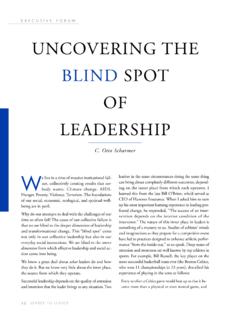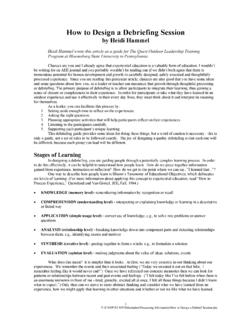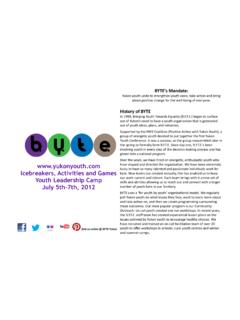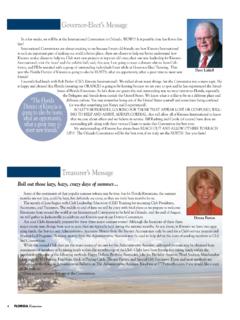Transcription of Emergency Medical Services Management and …
1 Emergency Medical Services Management and leadership development in America: An Agenda for the Future National EMS Management Association October 2008 - 2 - Table of Contents I. The Vision 3 II. Introduction 4 A. The Purpose B. Background of Project and Process C. Note About Terminology D. The Link Between EMS Management and leadership and Patient Care E. Assumptions III. The Evolution of EMS Officers and Current Challenges 9 A. A Collective Blind Spot B. The Historical development of EMS Officers C. The EMS Officer Today D. Current Training and Education Opportunities IV. An Agenda for the Future 20 V. EMS Officer Levels and Competencies 22 A. Where We Are B. Where We Want To Be C. How To Get There VI. EMS Officer Experience, Training and Education Network 24 A. Where We Are B. Where We Want To Be C. How To Get There VII.
2 EMS Officer Credentialing 28 A. Where We Are B. Where We Want To Be C. How To Get There VIII. Observations and Lessons from Related Disciplines 29 A. Law Enforcement B. The Fire Service C. Healthcare Disciplines D. Military leadership development Models IX. Conclusions and Next Steps 38 Appendices A. Project Team B. Sample Documents - 3 - I. The Vision EMS officers are indispensible in the provision of prehospital Emergency Medical care from the smallest frontier volunteer response squad to the largest metropolitan EMS system. EMS officers include supervisors, managers, directors, administrators, coordinators, chiefs and anyone who has supervisory, Management or leadership responsibilities.
3 This document envisions a future in which the roles of EMS officers are recognized as fundamental to the delivery of quality patient care, are clearly defined, and are supported with appropriate experience, training, education and credentialing. EMS continues to evolve in both complexity and community importance. Demands for EMS continue to grow both in the volume of requests for service and in the scope of Services provided. Since 9/11 and Hurricane Katrina, recognition and expectations that EMS will play a substantial role on the frontline of national disaster preparedness and response has risen. As the national healthcare crisis worsens, EMS is the healthcare safety net and entry point for many segments of society. Increasingly, EMS is expected to play an active role in the prevention of injury and illness. The provision of high-quality clinical care and the success of regionalized cardiac, stroke and trauma care demand that EMS systems consistently deliver peak performance.
4 This ongoing evolution has made the operation and Management of the EMS delivery organization increasingly more complex in terms of design, operations, technology, finance, human resource Management , quality assurance and clinical care. This complexity calls for EMS officers who are capable, experienced, educated and prepared. The EMS officers of today and tomorrow must not only understand EMS systems and operations, they must be skilled in people Management and motivation, technology, finance, planning, problem solving and team building. Furthermore, they must be socially conscious, culturally sensitive and know how to manage complex systems in the midst of change and crisis. Communities, the public and employees expect EMS agencies to evolve and to be managed and led by capable and qualified officers. The EMS systems of today and tomorrow demand more than a scattered, on-the-job approach to officer development . They demand a clear, responsive and adaptive pathway for EMS officer development that builds on work already done, recognizes the achievements of current officers and propels EMS officer development to a new level.
5 The collective EMS community in America knows what is needed to develop effective EMS officers. This knowledge is scattered among diverse individuals, agencies, systems, training programs and educational institutions and must be pulled together to effectively develop the quality and quantity of EMS officers needed in the future. - 4 - In the vision of this document, EMS patients, EMS systems, EMS providers and communities all benefit from a structured approach to the recognition, preparation and credentialing of the next generation of EMS officers. In this vision, anyone desiring to explore a role in EMS supervision, Management or leadership will be able to clearly see what the role requires in terms of experience, knowledge, training and education. The roles of EMS officers will be clearly defined and the competencies needed to perform in each role will be described. Model curricula will guide training programs and academic institutions in offering appropriate courses, programs and degrees.
6 Training and educational opportunities will be easily available to developing officers and employers. The portability of an EMS officer s experience from agency to agency will be enhanced by a recognized credentialing process and employers will be able to prepare and recruit appropriately prepared officers for recognized job titles. Field providers will work with EMS officers who are appropriately prepared to create the optimum work setting for the best possible patient care and community service. The path to accomplishing this vision is one that honors the diversity of EMS in America, recognizes the importance of EMS officers in every aspect of the EMS system and invites wide participation in a consensus process that will shape the details of this vision. II. Introduction The development of the Emergency Medical Services manager and leader in America has been scattered, varied, uncoordinated and largely left to the individual and local EMS agency or system.
7 The time has come for a more uniform approach. When David Boyd, MD, was appointed by the President of the United States to serve as Chief of the Department of Health, Education and Welfare s Emergency Medical Services Division in 1974, he envisioned a regionalized systems approach to EMS development in which all regions would uniformly embrace 15 essential components as defined by his office. His vision was never realized. Instead, EMS in America has primarily evolved independently at the local level with the result being wide diversity in delivery models, patient care capabilities, funding mechanisms, staffing models, service levels, terminology, data collection, and performance measures. Since the 1980s, an increasing number of EMS industry leaders, scholars, analysts, policy makers, administrators and chiefs have called for more uniformity in Emergency Medical Services . Beginning in the late `80s and early `90s with such initiatives as the Utstein project1 that created uniform definitions, terminology, and recommended data sets, and 1 In June 1990 an international group of scientists concerned with research involving out-of-hospital cardiac arrest met at the Utstein Abbey in Stavanger, Norway.
8 Participants discussed the lack of standardized nomenclature and definitions as a key problem in research reports. A second meeting, the Utstein Consensus Conference, was held in December 1990 in Brighton, England. Recommendations from this follow-up conference were published simultaneously in American and European journals. The report included uniform definitions, terminology, and recommended data sets (the "Utstein style") to assist clinical investigators in reporting human resuscitation studies. Recommended Guidelines for Uniform Reporting of Data From Drowning: The Utstein Style Idris, MD, et al., Circulation. 2003;108:2565. - 5 - continuing through NHTSA s Uniform Prehospital EMS Dataset (1994), the EMS Agenda for the Future (1996), the EMS Education Agenda for the Future: A Systems Approach (2000), the National EMS Research Agenda (2001), the National EMS Information System (2001), the Rural and Frontier EMS Agenda for the Future (2004), the Trauma System Agenda for the Future (2004) and the soon-to-be-released EMS Workforce Agenda for the Future, more uniformity and a basis of evidence have consistently been key features of the vision of the future.
9 In 2006, the Institute of Medicine s (IOM) landmark report on the Future of Emergency Care: Emergency Medical Services At the Crossroads described the current challenges facing EMS as: insufficient coordination; uncertain quality of care; lack of readiness for disasters; divided professional identity and limited evidence base. The IOM report recommended a direction for Emergency care that envisioned a uniform systems approach in which all communities will be served by well planned and highly coordinated Emergency care Services that are accountable for their performance. 2 A consistent theme of the IOM report is the development of regionalized, accountable systems of Emergency care. Today many national groups, associations, state EMS offices and local agencies are making strides toward more uniformity in some aspects of EMS. For instance, all states and four territorial EMS offices have signed a memorandum of understanding, agreeing to promote and support the implementation of the National EMS Information System (NEMSIS).
10 3 While there is still some resistance, there is increasing uniformity of information and data sharing and the identification of best practices. It is in this spirit that we offer a vision for the future of EMS Management and leadership development in America. A. The Purpose This document describes a vision for the future and the elements of a plan to move forward. The vision s aperture is wide and conceptual and recognizes that many of the detailed actions needed to fulfill this vision will be the products of future projects. The specific purpose of this document is to: raise awareness about the current state of EMS Management ; organize industrywide concerns about Management development ; propose a broad vision for the future; outline a stepped process for realizing the vision; invite wide participation in future steps; and catalyze action. 2 Future of Emergency Care: Emergency Medical Services At the Crossroads, The National Academies Press, Washington, DC, 2006, p.





